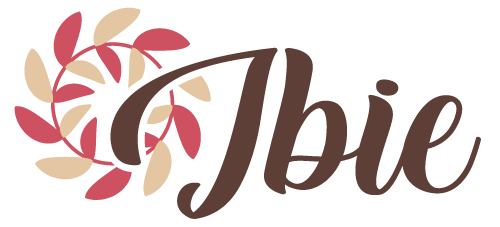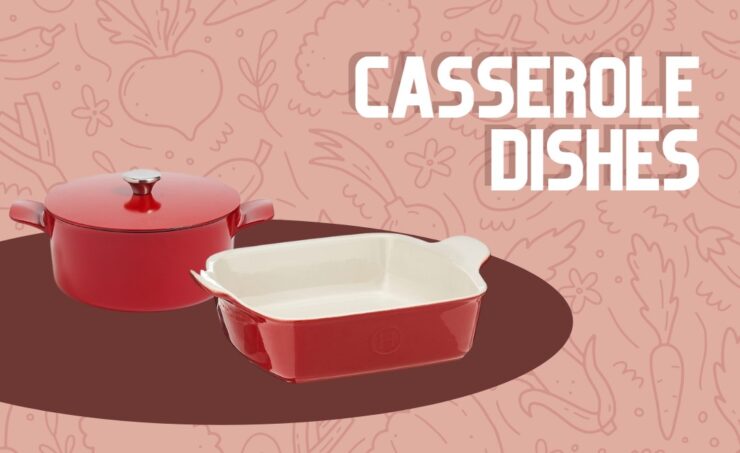They come in a wide variety of sizes to accommodate various cooking needs. From small individual-sized dishes to large family-sized dishes, there’s something for everyone. Knowing the available casserole dish sizes can help you decide which one is right for you.
Read on for more information about all of the different sizes.
Types of casserole dishes
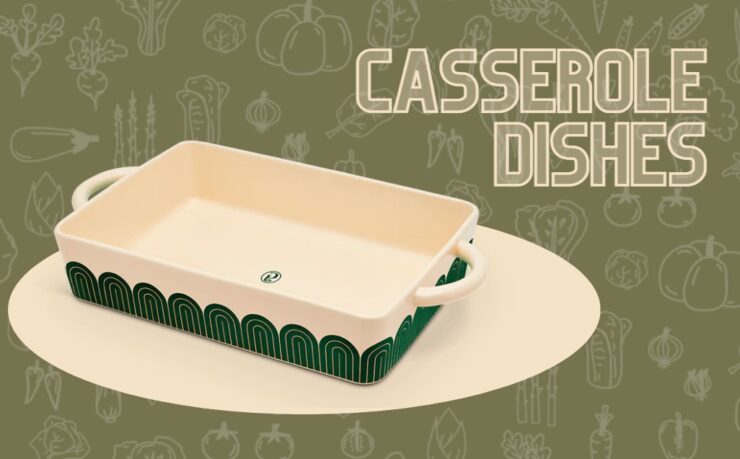
They can come in a variety of sizes, materials, and styles. The most common types are ceramic, glass, metal, and plastic. Depending on the type of material used, there may be slight variations in how the dish behaves or cooks when it is placed in an oven.
Additionally, the size of a casserole dish ranges from individual-sized to large family-sized dishes or even specialty sizes meant for specific recipes or uses.
The most commonly used sizes for casseroles are:
- Individual (1-quart capacity): Great for single portions with leftovers to spare. Often comes with a lid for easy storage.
- 2-quart: Holds 8 servings; perfect for a small group gathering such as game days and potlucks.
- 3-quart: Holds 12 to 14 servings; great for holiday meals and larger gatherings; lids often come included with these dishes.
- 4 to 6 quart: Generally used only by large families (12 people) or commercial kitchens; lid is usually not included; size varies based on type of material used but generally holds around 16 servings.
- 9×13 inch (sometimes called 13×9 inch): Most commonly used midrange size; versatile enough to serve anywhere from 8 to 12 servings depending on portion size desired by the host.
Dimensions
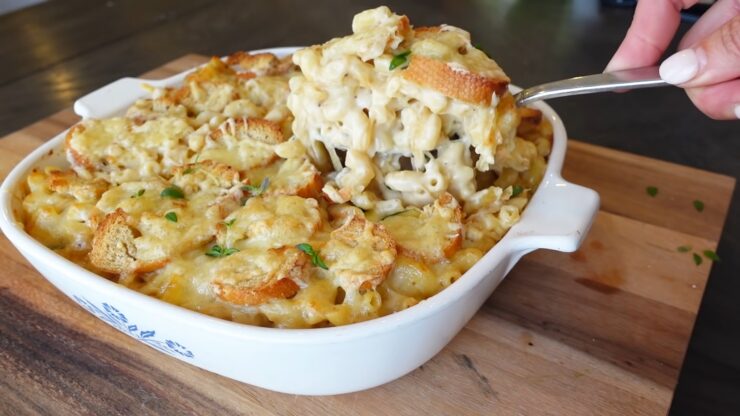
They come in various sizes and styles depending on the size of the dish and the amount of food you need it to hold. They can range from just a few inches in width up to several feet in diameter. Knowing the dimensions of the dish you need is essential in determining the right size to purchase.
Standard casserole dish sizes
Casseroles have been around for a long time and there are some standard sizes that will allow you to prepare the right amount of food for most households. The majority of casserole dishes measure 12” x 8”, 15” x 10”, or 13″x 9″. This size range will accommodate approximately four to six servings for a main dish, side, or dessert.
Some recipes require an oblong-shaped dish — like lasagna — and these are usually 13″ x 9″ with a depth of 3″. Soufflés, steamed puddings, and baked desserts can be prepared in baking dishes that are at least two inches deep. The popular round 8″ springform pan turns out lovely cheesecakes and tart crusts in no time.
For individual servings — breakfast muffins, for example — look for 6-oz custard cups or 4 ½ -inch ramekins that are designed with handles making them easy to hold and shake lightly during baking. Ceramic bakers come in many colors and shapes ranging from small squares to large oval ones perfect for dinner parties.
No matter what type of casserole dish you select, you should consider your needs before buying one as they come in various sizes designed to serve different quantities so will suit all kinds of cooking requirements.
Specialty casserole dish sizes
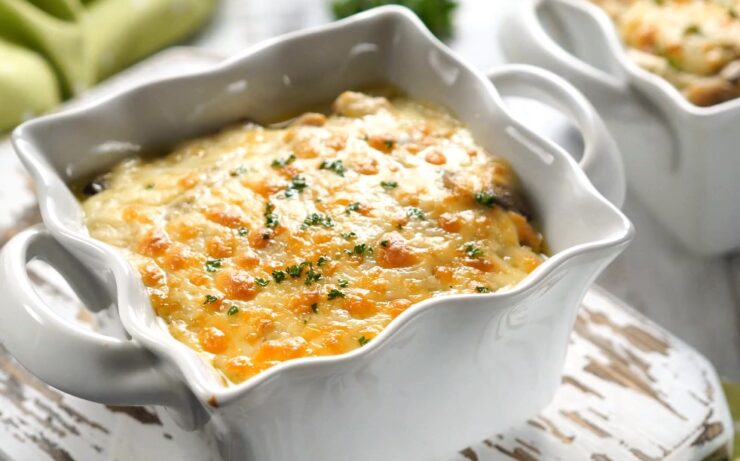
In addition to regular sizes, casserole dishes come in a wide range of specialty sizes perfect for hosting parties or making your own custom creations. These can be divided into four categories: miniature, individual, shallow and deep rectangular dishes.
Miniature ones are best for small appetizers or sharing desserts among a few individuals. They range in size from 1-4 cups and can be square or round. Individual casserole dishes are typically 4-6” in size and hold 8-12 oz worth of food (1-2 cups). They make great serving pieces when you want everyone to have their own dish – but don’t require large baking batches.
Shallow rectangular ones hold 2-3 quarts (8-12 cups) worth of food depending on the size you get. They usually measure 7×11” up to 14×20” with heights up to 2 inches deep. Perfect for more typical potluck fare such as mac and cheese, lasagna, enchiladas or other side dishes that need more area than depth for cooking evenly distributed meals that aren’t too thick.
Deep rectangular casseroles are what you think about when preparing Sunday dinner– perfectly sized for chicken pot pie, shepherd’s pie and others alike with its 3 quart capacity (13×9 inch).
Deep Rectangular Dishes can sometimes range anywhere from 9 inches wide by 12 inches long (3 qt) up to 15×10″ in size (6 qt). With a depth of 3+ inches these pans are perfect for fully baking entire meals together while ensuring nothing gets overcooked on one side like it can on shallow pans!
Care and Maintenance
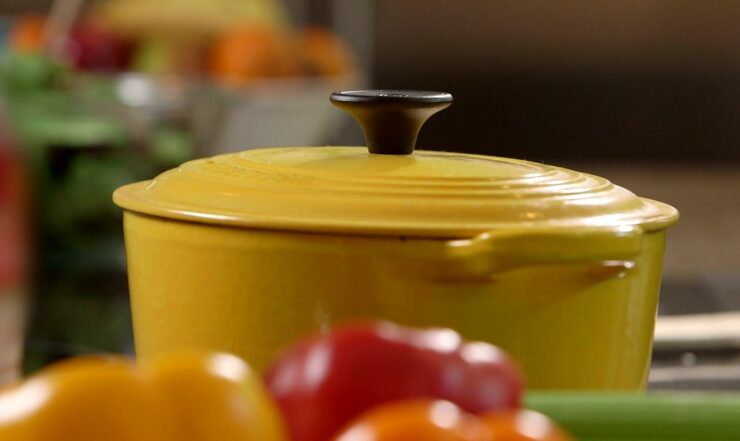
Caring for your casserole dishes does not have to be a complicated task. With proper care and maintenance, you can extend the life of your casserole dishes and get the most out of them.
To help you out, we’ll discuss how to properly care for your casserole dishes and the different sizes they come in.
Cleaning and storing casserole dishes
Caring for your casserole dishes requires more than just occasional cleaning. Proper storage and crowding, seasonal maintenance, and preventive care all help ensure that your stoneware casserole dishes retains its superior performance for years.
- Regular Cleaning: They should be washed with warm water in a sink or dishpan using a plastic scrubbing pad or brush for stubborn food residues. Use soap if desired, but generally it is not necessary as stoneware is nonporous and will not absorb odors.
- Storing: Wrap them before storing to prevent scratches and chips caused by any items stored with it. Also, avoid leaving it on countertops and other places exposed to direct sunlight or extreme temperatures. As a general rule, store him in a cupboard, because that limits exposure to excess moisture in the air which can cause rust spots on metal pieces like handles or hinges.
- Seasonal Maintenance: Once per year we recommend giving your dish some extra love and care through a thorough cleaning process which includes soaking in hot water with mild detergent then scrubbing with a brush and rinsing thoroughly twice before air drying – this helps clear away any surface dirt or stains that have built up over time since normal daily use.
- After drying; lightly coat the outside of clean surfaces with cooking oil (olive oil is recommended) to prevent food from sticking while baking and provide an added layer of protection against moisture damage during storage periods between uses.
- Preventive Care: To help keep them performing like new, try not to use them as serving plates or expose them to prolonged heat sources such as ovens set higher than 500℉ (260℃). Make sure you allow for even heat distribution when using utensils so that there won’t be any hot spots where food can burn easily – this can cause staining from the burned sugars contained within certain ingredients used during cooking processes!
Lastly, refrain from placing anything containing sodium (salt) onto heated surfaces of your dishes as this can result in calcium deposits being left behind overtime if not thoroughly cleaned off immediately after use each time – think about wiping down pre-cooking too!
How to prevent chips and cracks
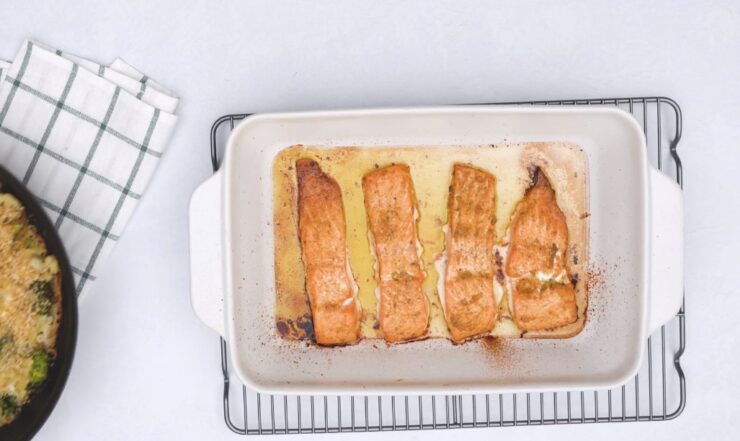
To prevent chips, cracks, and other damage to it, it’s important to take a few precautions. Use gentle detergents or homemade solutions when washing and rinsing the dish. Avoid using abrasive materials like steel wool or hard scrubbers that could damage the surface of the material. When preheating or reheating food, make sure that it is not too hot for the dish to handle before adding the food.
When stacking them, do not stack heavier items on top of lighter ones; instead, put several layers of towels on top of one another and place all dishes on top of that in order to evenly disperse the weight and reduce stress on any single item.
Additionally, consider investing in a protective lid or wrap if you plan on transporting your casserole dish, as this will keep food from spilling while en route and reduce risk of overheating during the transportation process.
Recipes
They are a great way to cook recipes in one easy step. Whether you’re cooking for a few or for a crowd, there’s a casserole dish size to fit your needs. From small individual dishes to large family-size dishes, there are many options available.
Let’s talk about some of the popular recipes and the sizes of casserole dishes that work with each.
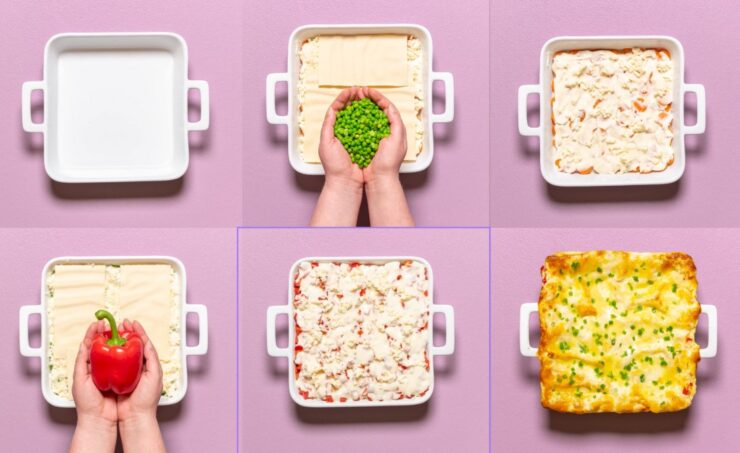
Popular casserole recipes
They are an essential dish in many homes and can come in a variety of shapes and sizes. The popular recipes will depend on the type that you are using but some favorite recipes include macaroni and cheese, chicken Divan, shepherd’s pie, pot pies and tuna casserole.
Oval ones are often used to bake chicken with a creamy sauce or to cook pasta because they fit larger cuts of meat or more pasta than other shaped dishes. It could be as small as 8-by-10 inches or large enough to hold an entire chicken at 14-by-10 inches, providing you with plenty of options for large family meals or significant holiday gatherings. For smaller batches or single servings you may find shallow casseroles in 5-by-7 inch sizes.
Rectangular casseroles come in several sizes from 13 inch pyrex pans that are about 2″ deep for larger items to the 9×13 pan which is the most popular size for baking cakes and breads as well as roasting food like potatoes, tomatoes and other vegetables.
These types of pans also come in smaller 6×8 inch pans which are great to just roast vegetables without having to use a large pan. Most rectangular casserole dishes also have lids so that they can be stored safely and easily transportable when needed.
The oblong shape is most often used for lasagna but can also be used for pot pies or enchiladas. Enameled cast iron is best suited for this type of pan because it cooks slowly and provides even heat distribution while cooking foods like beans, stews and chili’s evenly without burning them up…
The size usually depends on how many ingredients your recipe calls for but these pans come from 8 inch square sizes up to 15 inches long allowing room for larger servings required by larger families or special events such as Thanksgiving dinner!
Finally, pie plates make it easy to get creative with different types of savory quiches like bacon chive quiche muffins, breakfast egg tarts with mushrooms & spinach quiche cupcakes , goat cheese & leek savory tarts… T
hese versatile tools come in metal 11” round sheets deep enough for double layered tarts with multiple fillings! Aluminum foil varieties provide quick cleanup if desired but metal plates will provide more even heating from oven temperatures where aluminum may overcook easily in some cases!
You can even experiment by adding tortillas to your dish!
Tips for creating delicious casseroles
A dish that combines several ingredients of your choosing in one savory hit, casseroles are much simpler to make than they look. To craft the perfect casserole, there are a few tips to keep in mind.
The top element is key when making delicious casseroles. Whether you’re topping off with cheese or breadcrumbs, these items should be lightly spread on top for even coverage and texture throughout the pain. If using cheese, layer it in combination with other toppings such as parmesan crumbs or sesame seeds for more flavor and color variations.
When prepping your meat and veggies before adding them into the mix, use chopped pieces that are roughly equal sizes so everything cooks uniformly in each bite. If using dried spices be sure to sprinkle them evenly over all your layers; this will help infuse flavor evenly throughout the recipe without skewing any one component over another component taste-wise.
Finally, don’t be afraid to experiment by adding in extra elements like nuts or seeds — any slight change can turn a standard recipe into something special! With these tips fresh in mind, prepare yourself for an array of tasty results when creating unforgettable casseroles at home!
Snack food could be a great side dish to spice up your meal and add new taste to the dish.
FAQs
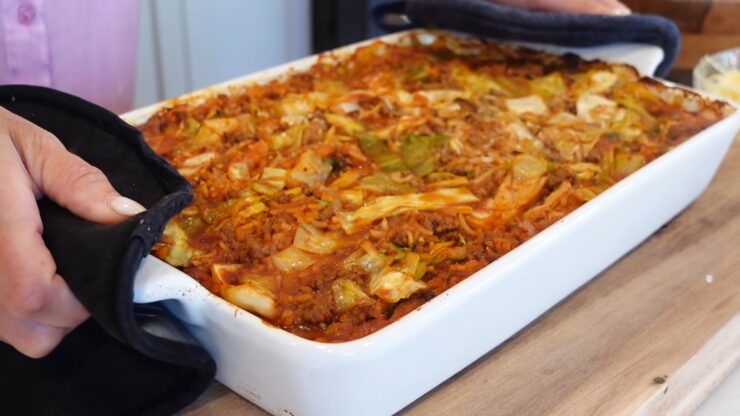
1. How do I choose the right size for my recipe?
The size you need depends on the recipe you’re making. It’s important to choose a dish that is the right size for your ingredients and that will allow room for expansion as the food cooks. As a general rule, a 9×13 inch dish is a good all-purpose size for many recipes.
2. Can I use a larger casserole dish than what the recipe calls for?
It’s generally safe to use a slightly larger baking dish than what the recipe calls for, as long as it is not too big. If it is too large, the food may not cook evenly and could dry out. If you’re unsure, it’s best to stick to the recommended size.
3. Can I use a smaller casserole dish than what the recipe calls for?
Using a smaller one than what the recipe calls for can result in the food overflowing or not cooking evenly. It’s best to use the recommended size or a slightly larger dish if needed.
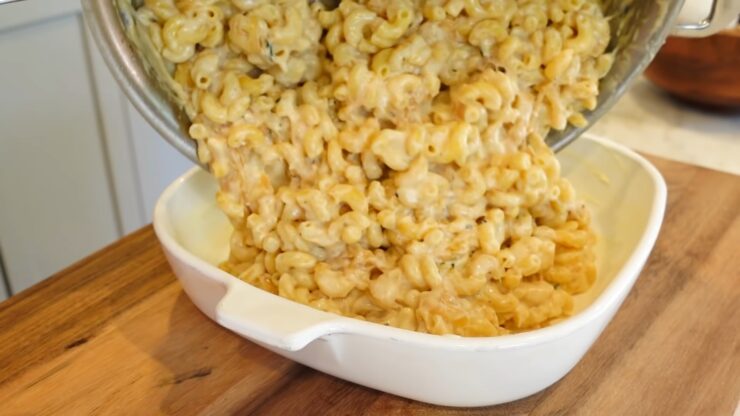
4. How do I measure the size of my casserole dish?
You can measure the size by measuring the length, width, and depth of the dish with a measuring tape or ruler. The dimensions are typically listed on the bottom or side of it.
5. What materials are casserole dishes made of?
They can be made of various materials, including glass, ceramic, metal, and stoneware. Each material has its own advantages and disadvantages, such as heat retention and durability.
6. Can casserole dishes be used on the stovetop?
It depends on the material. Glass and ceramic ones are not recommended for stovetop use, while metal and some stoneware dishes can be used on the stovetop. It’s important to check the manufacturer’s instructions before using it on the stovetop.
7. How do I clean it?
The best way to clean them depends on the material. Glass and ceramic ones can usually be washed in the dishwasher, while metal and stoneware ones may need to be washed by hand. It’s important to follow the manufacturer’s instructions for cleaning and care.
Conclusion
In conclusion, choosing the right size casserole dish is crucial for perfect cooking. By understanding the different dimensions and considering the recipe and ingredients, you can ensure that your dish cooks evenly and turns out just the way you want it.
Whether you prefer glass, ceramic, metal, or stoneware, there is a casserole dish out there that will meet your cooking needs. By following the manufacturer’s instructions for cleaning and care, you can also ensure that your casserole dish will last for many delicious meals to come.
